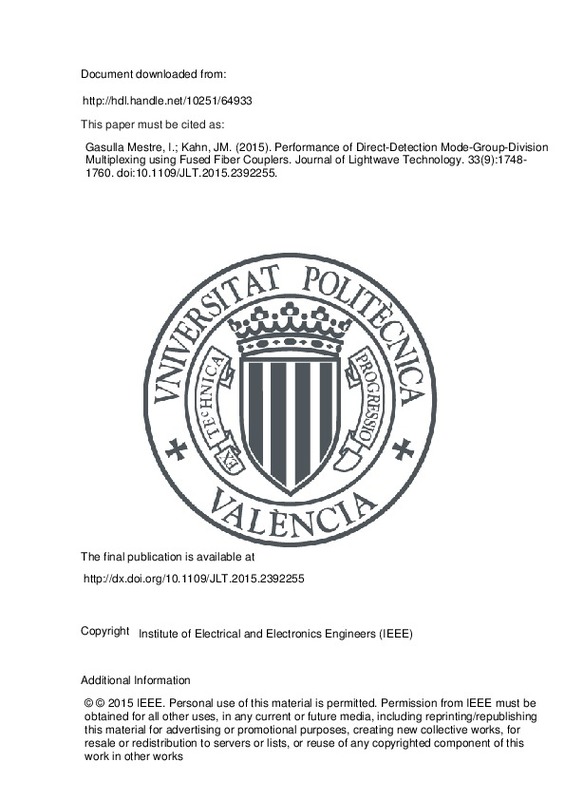JavaScript is disabled for your browser. Some features of this site may not work without it.
Buscar en RiuNet
Listar
Mi cuenta
Estadísticas
Ayuda RiuNet
Admin. UPV
Performance of Direct-Detection Mode-Group-Division Multiplexing using Fused Fiber Couplers
Mostrar el registro sencillo del ítem
Ficheros en el ítem
| dc.contributor.author | Gasulla Mestre, Ivana
|
es_ES |
| dc.contributor.author | Kahn, Joseph M.
|
es_ES |
| dc.date.accessioned | 2016-05-30T11:47:04Z | |
| dc.date.available | 2016-05-30T11:47:04Z | |
| dc.date.issued | 2015-05-01 | |
| dc.identifier.issn | 0733-8724 | |
| dc.identifier.uri | http://hdl.handle.net/10251/64933 | |
| dc.description | © 2015 IEEE. Personal use of this material is permitted. Permission from IEEE must be obtained for all other uses, in any current or future media, including reprinting/republishing this material for advertising or promotional purposes, creating new collective works, for resale or redistribution to servers or lists, or reuse of any copyrighted component of this work in other works | es_ES |
| dc.description.abstract | [EN] We present an end-to-end performance evaluation of a mode-group-division multiplexing system that uses direct detection instead of coherent detection, avoiding complex digital signal processing. The system transmits four data channels through a step-index fiber supporting six spatial modes comprising four mode groups, considering the two-fold degeneracy of the LPlm modes for l ≠ 0. Multiplexing and demultiplexing is performed using two- and three-core fused fiber couplers, each one phase-matched to a group of degenerate modes. These devices are analyzed through a field-based model that describes, for the first time to our knowledge, crosstalk between all the fiber modes. Propagation through the few-mode fiber is modeled considering differential modal attenuation, intermodal dispersion, chromatic dispersion, and both intergroup and intragroup modal coupling. The end-to-end link is described by a concatenation of matrix operators describing the optical field transfer functions for the multiplexer, fiber and demultiplexer. Error-free transmission of four 32-Gb/s OOK modulated data channels through a 1-km link proves the feasibility of the proposed direct-detection mode-group-division multiplexing approach. | es_ES |
| dc.description.sponsorship | The work of I. Gasulla was supported by the Fulbright Commission and the Spanish Ministerio de Educacion through the Programa Nacional de Movilidad de Recursos Humanos del Plan Nacional de I-D + i2008-2011. The work of J. M. Kahn was supported by a Google Faculty Research Award. | |
| dc.language | Inglés | es_ES |
| dc.publisher | Institute of Electrical and Electronics Engineers (IEEE) | es_ES |
| dc.relation.ispartof | Journal of Lightwave Technology | es_ES |
| dc.rights | Reserva de todos los derechos | es_ES |
| dc.subject | Few-mode fibers (FMFs) | es_ES |
| dc.subject | Optical fiber communication | es_ES |
| dc.subject | Mode-group-division multiplexing (MGDM) | es_ES |
| dc.subject.classification | TEORIA DE LA SEÑAL Y COMUNICACIONES | es_ES |
| dc.title | Performance of Direct-Detection Mode-Group-Division Multiplexing using Fused Fiber Couplers | es_ES |
| dc.type | Artículo | es_ES |
| dc.identifier.doi | 10.1109/JLT.2015.2392255 | |
| dc.rights.accessRights | Abierto | es_ES |
| dc.contributor.affiliation | Universitat Politècnica de València. Instituto Universitario de Telecomunicación y Aplicaciones Multimedia - Institut Universitari de Telecomunicacions i Aplicacions Multimèdia | es_ES |
| dc.description.bibliographicCitation | Gasulla Mestre, I.; Kahn, JM. (2015). Performance of Direct-Detection Mode-Group-Division Multiplexing using Fused Fiber Couplers. Journal of Lightwave Technology. 33(9):1748-1760. doi:10.1109/JLT.2015.2392255 | es_ES |
| dc.description.accrualMethod | S | es_ES |
| dc.relation.publisherversion | http://dx.doi.org/10.1109/JLT.2015.2392255 | es_ES |
| dc.description.upvformatpinicio | 1748 | es_ES |
| dc.description.upvformatpfin | 1760 | es_ES |
| dc.type.version | info:eu-repo/semantics/publishedVersion | es_ES |
| dc.description.volume | 33 | es_ES |
| dc.description.issue | 9 | es_ES |
| dc.relation.senia | 282432 | es_ES |
| dc.contributor.funder | Fulbright Commission | |
| dc.contributor.funder | Ministerio de Educación | |
| dc.contributor.funder |







![[Cerrado]](/themes/UPV/images/candado.png)

